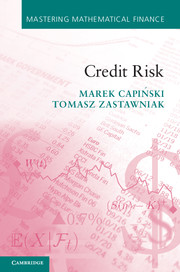2 - Hazard function model and no arbitrage
Published online by Cambridge University Press: 05 January 2017
Summary
We are going to study the so-called reduced-form approach as an alternative to structural models of credit risk. The default of a company will be an exogenous event, happening unexpectedly and without a direct link to the state of the company. This is a documented possibility; companies can indeed go bankrupt without warning.
A common feature in such default events is a new piece of information that is revealed, affecting the company's existence. For instance, a new scientific discovery could make the production technology obsolete or it might reduce the demand for the company's product. A court decision could damage the financial position of the company. A political event might wipe out the demand for the company's product or services in a critical region. In such cases default can happen even if the company has been in a good shape prior to the triggering event. An additional possibility is when the financial statements are doctored to cover poor performance, and the true financial state of the company suddenly becomes public knowledge.
Default will be assumed to occur at a random time τ, not directly linked to the functioning of the company, though in general not independent of it.
Market model
The model involves two types of securities, default-free and defaultable.
We begin with the simple case when there is just one default-free asset, a risk-free zero-coupon bond with maturity date T > 0 and unit face value, whose price at any time t ∈ [0, T] is determined by a constant risk-free rate r as
In Chapter 5 we are going to add another default-free asset, a risky one such as some stock or an index.
In addition to the default-free bond, suppose there is a defaultable zero-coupon bond with maturity T and unit face value, issued by a company which may default in the future. Let a random variable τ > 0 be the time of default. The value of the defaultable bond at time t ∈ [0, T] will be denoted by D(t, T). The bond holder will receive the face value at time T if the company does not default up to and including time T, that is, if T < τ.
- Type
- Chapter
- Information
- Credit Risk , pp. 39 - 70Publisher: Cambridge University PressPrint publication year: 2016



